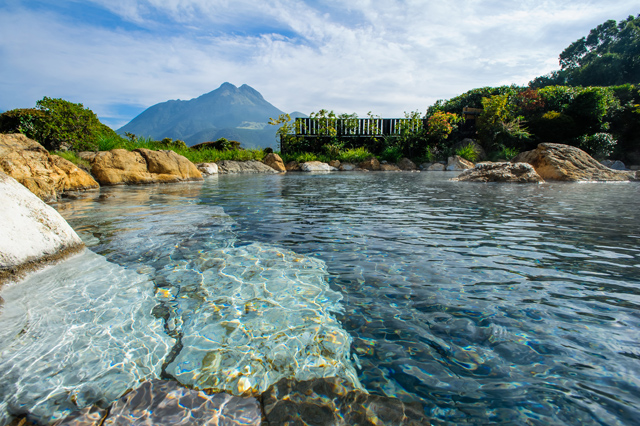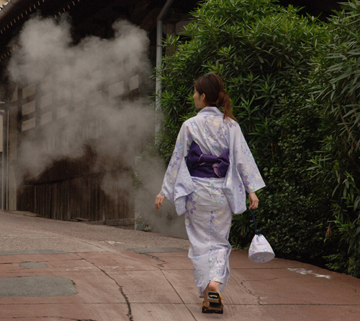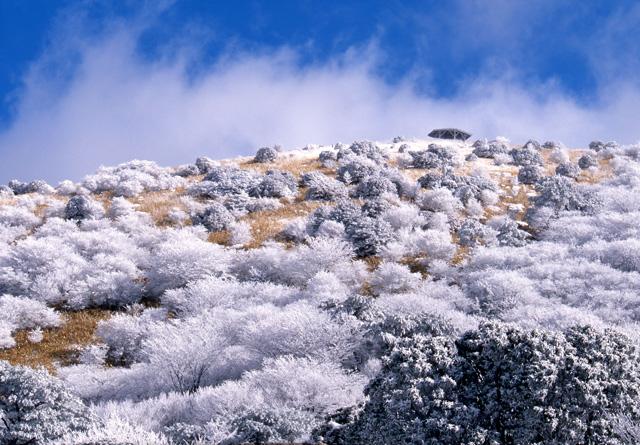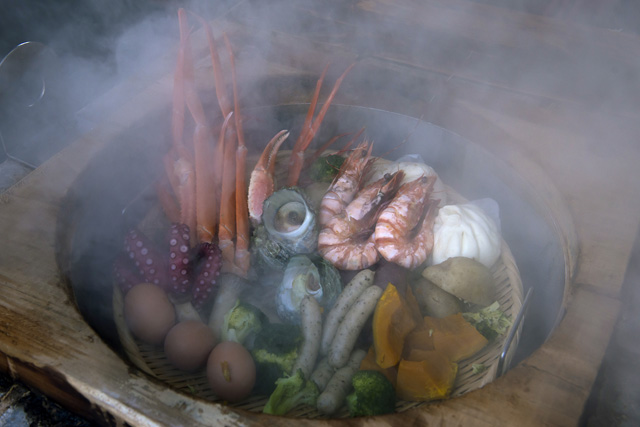Soaking in an onsen until all of the tension seeps out of your body, you get up and cool yourself off in a cooler bath, or maybe you move out to the open air bath. You think about your schedule for the rest of the day. It’s completely packed: two or three more onsen to try, a visit to some spectacularly colored hot springs, and two hearty meals. A vacation in Beppu can be tough, but you can handle it.
A short trip south from the Oita Airport, Beppu is perhaps the most popular of Oita’s onsen resort towns. The group of eight hot springs around the city are known collectively as the Beppu Hattō, and host millions of visitors who come each year for “onsen pilgrimages.”
Hot Springs
The many hot springs in the region area are rich in different minerals, which make for onsen of many colors and qualities. Baths drawn with water that is rich in carbonates is said to be good for skin conditions, for example, and while the smell of sulfur may put people off, it is believed to be good for high blood pressure. Like a well prepared multi-course meal, the cumulative effect of soaking in various baths, one after the other, can be an unforgettable experience.
You might not think that you could earn rewards for soaking in Beppu’s many hot springs, but if you fancy attaining the title of “Hot Spring Master,” you should step up to the challenge. If you visit all 88 of the onsen in Beppu (it might take you more than one visit!), you will receive a certificate from the city’s tourist association that commemorates your achievement.
The hottest springs around Beppu are not meant for soaking in: the jigoku, or “hells,” are colorful and impressive demonstrations of nature’s force. Like the onsen around the town, these picturesque hot springs each have their colorful appeal: a tour of Beppu’s hot springs will take you to the turquoise blue waters of the umi jigoku (or “ocean hell”) and the iron-stained chinoike jigoku—fearsomely dubbed the “blood pond hell,” it is said to be the oldest of these natural hot springs around Japan.
If you want to step away from the relaxation of Beppu’s hot springs, the Aso-Kujyu National Park and Mt. Tsurumi are only a short cable car ride away. The peak of the volcanic mountain offers stunning views of the surrounding land and the waters of the Inland Sea. The area is spectacular during the winter, when frost covers the foliage around the park.
The Flavors of Beppu
The forces underneath the earth are even used for the local cuisine. Jigokumushi, a cooking technique that is both ecologically conscious and healthful, harnesses the power of geothermal heat to steam food in baskets. Thanks to the natural flavors of the quality ingredients that Oita is known for and the various minerals of the hot springs, you can expect a heavenly taste from a style of cooking whose name translates as “hell steaming.”
Some of the town’s other culinary specialties that you shouldn’t miss during your stay include Beppu’s famous reimen, a cold noodle dish that can be a welcome cooldown from the warmth of the baths, even in the middle of winter, and the secret recipe of Beppu toriten, fried chicken that is prepared to have a perfect balance of crunch and tenderness. Many of the onsen, cafés, and hotels of Beppu specialize in a sweet enticement to tempt visitors to drop in during their onsen pilgrimages. Just like the varied qualities of onsen in Beppu, the local pudding comes in wide varieties of sweetness, firmness, and color, for a delight to any palate.
After experiencing the slow life and relaxation of Beppu, all of the busyness of your daily life just might disappear like vapor above the air of this hot spring city.
How to Get There
90+ minutes by air from Tokyo to Oita Airport
70+ minutes by ferry from Oita to Ehime on the Uwajima-Unyu ferry line












